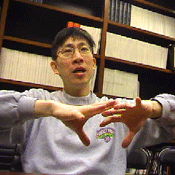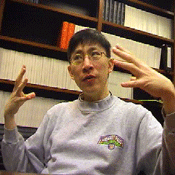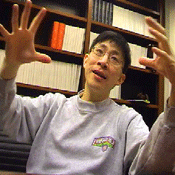Conversation
with Astronomer Charles Liu - March 9, 2006
Professor
of Astrophysics
The
City University of New York
College
of Staten Island
Department
of Eng Sci and Physics
Research
Scientist
Department of Physics
and Astronomy
Barnard College
Columbia University
Associate
The Hayden Planetarium and
Dept of Astrophysics
Division of Physical
Sciences
American Museum of
Natural History
PG - So, originally the idea was to start with the One thing, the singularity, and having it separate into the Four Forces. Then as they separate and break off from each other, as far as chaos goes, it's a bifurcation of sorts. This falls within my love of polyphony and I'm thinking it might be interesting to…it's a nice balance that, as everything slows down and expands, there's always this balance i.e. more detail and complexity as things expand. Though, I don't want to make it too balanced because that would be static. Symmetry's cool as long as there's that one thing that sets it off. You know what I mean. So, I'm just playing with that idea.
===============================================================
PG - ...and Gravitons...?
CL - Well, that's a Quantum Mechanical aspect. The Graviton is a QM construct. Einstein never thought about particles that carried Gravity. He just sort of said, "Gravity naturally happens because Space exists. The Quantum theorists said, "Well, that not actually how force works on the tiniest scales. The way force gets exchanged is when you send a particle from one thing to another. You have to send a particle. For example, if you're exchanging Electromagnetism…
PG - What I got out of String Theory is that Gravitons might be as strong as the other forces except that they move through branes.
CL - Right. That's really something that's, at this point, unprovable. It's untestable. It doesn't mean that it's invalid.
PG - Well, that's the thing. Our friend Steve (Weinberg) says that it's the perfect theory because it's untestable. Now, if it's untestable, is it a physics or is it a philosophy?
CL - Right. So for now we should stick with theory and we'll do philosophy some other time.
===============================================================
PG - Very good. Let's see now, I just want to move quickly. (Looks at Big Bang Timeline) For me, it starts to thin out as it goes along. Is Dark Matter part of the time of Radiation?
CL - No. matter and Radiation are very different at that point. The separation from matter and Energy is what is called "de-coupling" which happens around 300,000 years after the Big Bang. That's when Dark Matter, or the Luminous matter, start acting independently of the energy that's floating around.
PG - (Looking at Timeline) OK, there's Planck Time, separation of the Strong Force. OK, but Planck Time, that suggests Gravity?
CL - Within the Planck Time? You mean before?
PG - No, no, at the Planck Time.
CL - Yeah At 10-43 seconds that is when Gravity is working at that point.
PG - OK…the Strong Force, we talked about the Inflationary Period…quarks and anti-quarks begin forming, the Grand Unification Period? As they put it, which comes right before the Weak Force separates?
CL - If you call that era the Grand Unification Period…
PG - Hey, we just pulled this chart off of Answers.com…
CL - And they got it from Wikipedia and they're usually correct. Correct by consensus. That period there the GU Period, that's just a time when all the forces were somehow connected. One way or another. The Electroweak Force breaks off from the Electromagnetic. When that happens, that's the last force, the last of the four forces that now stands alone. So, before that time, the period when the GU idea is important, every time you break off another force, the Universe comes closer and closer to the way that it works today. So, before that, things are fundamentally different.
===============================================================
PG - So, looking at this chart now, is there anything, in your opinion, that is the most dramatic? What's the stuff that's like, "Wow, this was really something when this happened!" or are they all equally amazing?
CL - The thing that I like is when you get the quark gluons at about 10-6 or 10-5 seconds. See, at this point, starting at around a millionth of a second and maybe a little before then, during the millionth of a second period on up is when matter as we know it begins to exist. Electrons and neutrinos, protons eventually, then neutrons as we know them. So you have to build up what they call the Lepton which makes up you electrons and neutrinos, quarks: up and down etc. The things that hold all these together are the gluons. So, when you weren't sure yet that the quarks were going to form individual particles. That's the 10-5 period.
PG - So, is that this period here where quarks and Anti-quarks begin to form, and during all this, they're hashing out their differences and in the meantime the larger forces are separating? Is it quite possible that the very separation of these forces made this stage all possible?
CL - Yeah. Without the separation of those forces the gluons and quarks would not have pulled together to form atomic nuclei, protons, everything like that.
===============================================================
PG - OK, so looking at the Timeline we have Photons now…
CL - Right, and the Photons are the things that squirt out of the Electromagnetic Force, they carry the Electromagnetic Force.
PG - So, when did Photons come into being? At the very beginning?
CL - Does it say so? I actually don't know for sure. I think it's about 10-5.
PG - So, theoretically then, everything before that happened in darkness?
CL - It all happened with so much energy density that particles like Photons couldn't even escape. The concept of them then is very hard to grasp.
PG - I think I just caught my own question then.
===============================================================
CL - OK. What we got here at this point, when the Cosmic Microwave Background Radiation is formed, this period of Re-combination, De-coupling, they all happen around the same time. At this point, at the 300,000 to 400,000 year mark, then finally when they separate, then matter is able to do its thing with Gravity. Then light gets spread out throughout the whole Universe. It begins to get more transparent at this point.
You can think of the Universe as being like a fog for a long time. What happens in fog, here on Earth, a whole bunch of water particles which are really droplets, so you're standing in droplets. Now, if you try to shine a flashlight into the fog, what happens? The light beam hits the fog and gets refracted back and gets scattered into a scattered blinding glare. It's a two-way street, back in the "old days," around the third million year mark or so. When you shine the light it knocks into the matter so the light can't get through.
But if the matter tries to move, there's so much light that it actually drags on the matter. When light hits a mirror it bounces off. But if so much light hits a mirror, it can actually produce a pressure and move the mirror backward because Photons have momentum. And so what was happening was that there was so much light floating around in the Universe as an energy density.
PG - Creating like an aerodynamic drag?
CL - Right. So say you have a particle here (holds out hand) and a particle here (holds out other hand) and they're trying to pull together because of Gravity. Their actions are so pulled out because the light is pushing them this way or pulling them that way so they can't move independently of light. That was when they were all tied together (intertwines fingers). So when this De-coupling happens, at this point in time, this last thing on the Timeline, the energy density and the matter density both get low enough they no longer drag on one another.
So that way the Cosmic Background Energy just gets spread out slowly. Today its microwaves but back then it was 3000° Kelvin. That's quite hot and now it's very, very cold but that energy is still there, it's just been spread out over a very, very large volume. Meanwhile the matter, which had been pulled and pushed and interfered with by all that energy, is now free to stream on its own, to interact with other matter.
So now, Gravity begins to dominate the behavior of matter. That's a very substantial event where matter finally begins to move independently because of Gravity and nothing else. Light, primarily now, just occupies Space without having a pull on matter. That separation is extremely important. It made it possible now for things like stars to form and that made it possible for us to today see all the other stuff that happened, the forming of elements etc. That's the important part, the figurative fog lifting.
The story's not over quite yet because after that, for about another several hundred million years later, there's a lot of matter, it's all Hydrogen and Helium and little tiny bits of other stuff.
===============================================================
PG - Now this I've got a good grip on: how through fusion in stars all of the elements get created.
CL - Yes, that would be in a star. But before the first stars formed, after this separation of energy and matter in the Universe, there was a period of time when all there was, was just cloudy stuff in which matter could travel but there was nothing to shine, nothing shone. So after the first stars did form then light existed. This light when it shined out was like shining a flashlight into a fog because the matter particles are still there. We needed the stars to burn away the fog.
But to generate enough ultra-violet radiation to knock the electrons and protons apart so that they're independent of one another and travel without being hit and stopped, that second process is called the Re-Ionization of the Universe. Originally the Universe is ionized because it was so hot, protons and electrons can't hang onto one another. But then the Universe becomes neutral after this separation of matter and energy and then it gets re-ionized so that light can travel.
If most of the matter in interstellar space were not ionized it would neutralize. If a beam of light came from a distant source it would inevitably hit so many atoms that it could never shine through.
===============================================================
PG - OK. How does this relate to the kind of ionization that takes place during a thunderstorm? That has a correlation, doesn't it?
CL - Hmmm. Yes it does. Let me think about this… When a storm happens you are sending static electricity from the ground to the cloud or from the cloud to the ground, either way, when that happens you create a channel of plasma, electrically charge (ionized) gas. There's a channel that goes from one to the next and that channel of electrically charged gas is basically lightning. So, for a brief moment on Earth where the atmosphere is usually not ionized, for a brief moment that area is ionized. Light, electricity etc. travels right through there.
PG - Good. Now, for a guy like me, what little I know about electricity and electronics, I want to speak of "potential difference." When we speak of anything that is ionized, we're speaking of difference.
CL - Yes, we can be. You could say it that way, from what it normally is.
PG - I mean it in the sense that, we're talking about flashing a flashlight against that fog, when the Universe became ionized, when everything separated, oh I'm not using scientific terms at all…
CL - That's alright. The things that used to be proton-plus-electron became proton flying off here and electron flying off there.
===============================================================
PG - Good, I'll back that up. Now, I think I'm going to finish with one last thing. I like this idea of telling the story backwards. So, say that I was to, I know that we're talking about incredible powers of ten, so if I were to start out with today and then move backwards, could you take me back through a couple of steps, in retrograde fashion? So, where are we today?
CL - Now we're in an era when stars are important. Really though, the biggest structures in the Universe are the super-clusters, which are thousands and thousands of galaxies. As you step backwards…
PG - They're functioning as a unit?
CL - Well, actually like nodes of a web. You can think of matter being spread out in big webs and at the nodes of the webs are groups of thousands and thousands of galaxies.
PG - "Aggregates" could be another word?
CL - Yes. As you move further and further back in time those aggregates are more and more separated and with less structure, more and more uniform as you move back in the time that Gravity has been able to interact with these structures. So right now, Super-Clusters are the largest structures in the Universe.
As you go further back, you see that the clusters are not so big. And you go further back still and you see that the clusters aren't really there at all, that there's only a really tiny bit but you do see galaxies which themselves are huge amounts of mass.
Then even further back galaxies aren't really there either, maybe a billion or so years ago. There's no galaxies as we know them today. There's clumps of matter, maybe millions of stars or maybe even billions but nothing like a hundred billion. Not as many as now.
Go back even further and you wind up with a Universe of individual stars that were huge, much, much bigger than our current Sun, but they're stars. That's the biggest structure.
PG - Is this a function of Gravity or something else?
CL - It is. It's Gravity playing out itself through Time. You wait 13 billion years and things get bigger and bigger into larger structures.
PG - Is that like if I had a pail of some fluid with stuff floating in it and then vigorously stirred it up?
CL - Well, it starts out stirred and then you let it go about its natural course and through entropy it would begin to create its own patterns. Something like that. But in this case there is no Magic Hand, right? Basically it starts out uniform but we're going backwards in Time so you're starting out with high structure and structures become less and less. You start out with galaxies, then just sub-galactic clumps, then just the stars themselves.
Then if you go even further back there aren't even stars. There's just swirling gas seeming to be making snake-like patterns throughout the Universe.
PG - So, no fusion.
CL - Right. You have to get enough mass together to collapse under its own weight until they produce at their center the temperature and pressure needed to make nuclear fusion.
Then you go back in time some more and now the gas is locked in tight with the light, back to the fog we were talking about.
Then from there we go through the period before separation so you have all this matter and energy tied together,
You go back further and you lose all distinction. You can't even tell the difference between matter and energy they're so interchangeable.
PG - Like the optical illusion where you can't tell if it's a picture of a vase or of two faces, convex and concave?
CL - No, it's a good question though. What's basically happening, how I see it, is that they become one another so readily. The environment is so hot and so dense that particles and anti-particles are annihilated in creating energy and the timing of that is so rapid that the distinction between the particles is lost because of these physical processes. Eventually matter cannot exist because it's so hot and so dense and you just have this tight bundle of energy.
And that's it.
PG - Everything was infinitely heavier…
CL - Not heavier but denser. There's a difference.
PG - I guess I said heavier because I was thinking about Gravity.
CL - Then you end up at Planck Time where the density was 1097 times greater than water.
PG - I can see why we need those numbers (powers of ten) because we can't really compare it to anything we really know.
CL - No, I'm afraid not. I talk about stars a lot in my classes. A little tiny brown dwarf star is a million times less luminous than our Sun. Our Sun is a million times less luminous than Rigel for example. Imagine a thousand 1000 watt light bulbs compared to a tiny night light. That's the difference. Wow!
===============================================================



